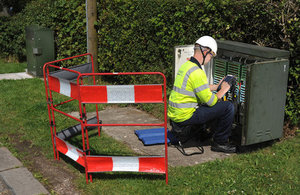Two million more homes and businesses can get superfast broadband
Four out of five UK properties can now access superfast speeds. Latest figures revealed as next stage of tackling the final five per cent of hardest to reach areas in the UK begins.

The Government’s nationwide rollout of superfast broadband has now reached more than two million homes and businesses, figures published today reveal.
The rollout is delivering superfast access - internet speeds greater than 24 Mbps - to those properties not covered by existing commercial networks and is on track to take superfast access to 95 per cent of the UK by 2017. The UK already leads the EU “big five” nations when it comes to superfast access and take-up and the programme will ensure it stays ahead.
Government recognises the importance of a fast internet connection to individuals and businesses alike, and it’s £1.7bn investment in the rollout is a key part of the Government’s long term economic plan. Around 80 per cent of the UK already has access to superfast speeds, and the rollout is currently reaching an additional 40,000 homes and businesses every week.
Culture Secretary Sajid Javid said:
“Today there are two million more UK homes and businesses with access to superfast broadband than there were two years ago as a result of this ambitious project. This is a tremendous result that is already making a huge difference to millions of people. We want everyone in the UK to be able to enjoy the benefits of superfast broadband, that’s why we’ve begun work on reaching the last five per cent of communities not covered by existing plans.”
Faster broadband is a catalyst for economic growth, and its estimated that the Government rollout will result in the creation of 56,000 more jobs in the UK by 2024. Superfast broadband will be pivotal in driving profits for local businesses, and rural economies are set to benefit by around £9 million every day due to the work being done now.
Project partners BT are now rolling out the fibre-optic cable at maximum speed, with great progress to date in each geographical area of the UK:
| Country / Region | Homes and businesses reached by the Government rollout |
|---|---|
| North East England | 85,048 |
| Yorkshire and the Humber | 232,536 |
| North West England | 272,894 |
| Midlands | 291,985 |
| South East England | 265,935 |
| South West England | 200,272 |
| East of England | 288,729 |
| Scotland | 220,000 |
| Wales | 299,876 |
| Northern Ireland | 17,500 |
Joe Garner, CEO of Openreach, BT’s local network business, said:
“We’re proud to be delivering this great British success story in partnership with the Government, and have committed up to £1billion of our shareholders’ money to the projects. The programme is on schedule overall and our people continue to work flat-out on connecting homes and business in the UK’s hard-to-reach areas. If we come in under budget, savings can be reinvested to take coverage even further. Funds will also be released if take-up exceeds expectations, all of which is further great value for the taxpayer.”
The Government’s rollout clearly demonstrates value for money, and much of the current work is already ahead of schedule. Focus is now firmly placed on the hardest to reach areas that make up the “final five per cent” of the UK not covered by existing plans, and Government has already begun work on extending superfast coverage to these communities.
The Government confirmed today that seven pilot schemes aimed at helping to reach these areas will now move into deployment, having successfully completed the first stage of a trial period. One of the trials in Exmoor will very shortly be delivering superfast broadband to homes via satellite delivery. This is the first time that satellite will be used to deliver superfast speeds to residential customers in the UK at affordable prices.
The seven schemes will:
- Generate evidence about the cost of delivering superfast speeds in these hardest to reach areas, in order to better understand the level of public investment that will be needed
- Build capacity and capability in the market, and increase the market’s knowledge of State aid requirements, by sharing the pilot findings as widely as possible
- Generate evidence about expected levels of take-up in hardest to reach areas, and how it can be incentivised
Note to editors:
- Additional information on the different technologies being used to reach the “final 5%” has been published.
- For a project-by-project breakdown of the two million premises reached by the BDUK rollout, please contact ken.hunt@culture.gov.uk
- The Recent NAO report recognised that the rollout is ahead of schedule and will be delivered under budget, with the significant savings being made due to be reinvested in taking the rollout even further.